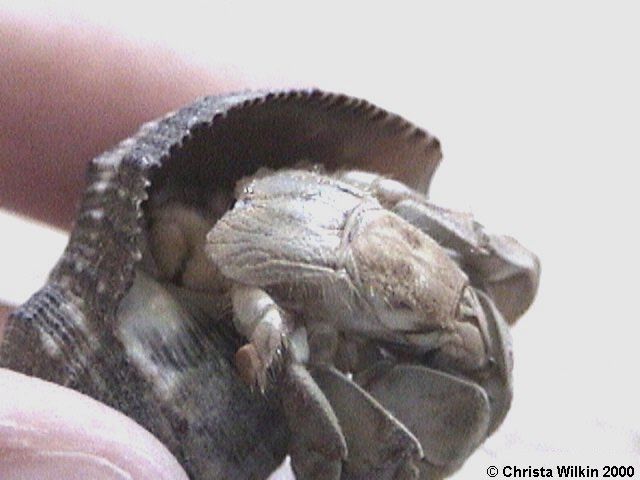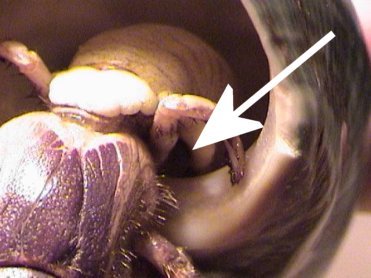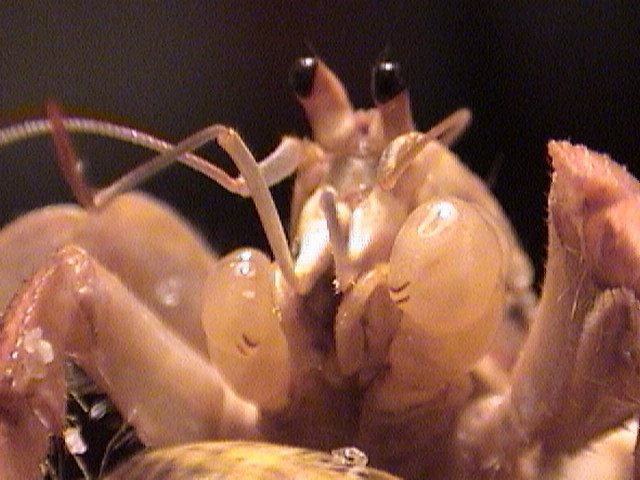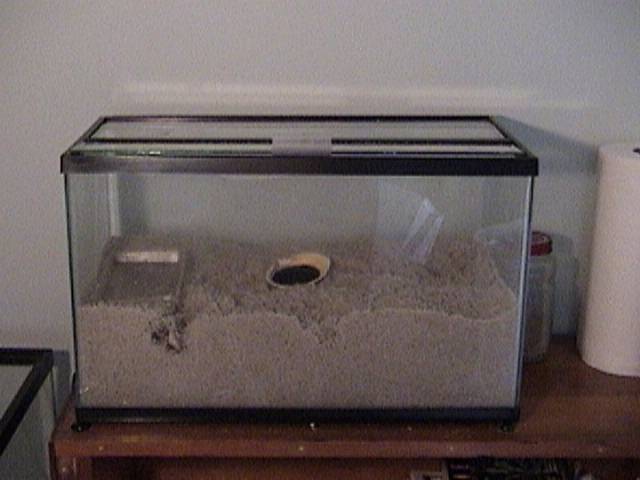
New Molt. Look behind the old skin and you'll see the new claw of the actual crab!
Molting Demystified!
Clues that the miracle of molting is near:
There are a lot of little signs that a hermit crab gives its owner before it needs to molt (shed its skin). This page details most of them, and describes how to set up an isolation tank so your crab makes it through this difficult time.
If your hermit crab has just molted and you are looking for immediate help, please scroll down to the Surprise! section. New Molt. Look behind the old skin and you'll see the new claw of the actual crab! |
Crabbie is digging! An otherwise healthy crab that is suddenly overcome with an urge to dig is your first clue that a molt might be on the way. Before you assume this, however, check your trusty thermometer and humidity gauge. A tank that is too warm, cold or dry could cause your crab to dig himself a little "microhabitat" under the sand where he is insulated from conditions he does not like. Newly purchased crabs in particular are prone to dig into the substrate for a while. Sometimes they do this only because they want to rest, and sometimes it is because they are indeed molting. Pet store conditions are rarely optimal for a molt, so if your new crab digs in, leave him alone. It might be hard for you to do, because you just got your new pet and you want to get to know him. However it is best for him (and for you in the long run) if you let him acclimate to his surroundings on HIS time. Smooth out the sand over and around him Then if he decides to pop up at night for a drink or a bite to eat, you'll know that he is only destressing, and probably not molting. The FAQ page contains this info and more about digging crabs, and explains what to do about certain behavior.
Is Crabbie drinking or
eating a lot? A molt might be on the way, but first, let's
look for some other clues. Molting hermit crabs have a
two-pronged strategy for molting: 1) store up a lot of fat and water
and 2) get  underground to molt. So before your crab goes
shell-up and heads for the bottom of his crabitat, he may eat and drink
like you've never seen before. The confusing part of it is that he will
probably do all his "tanking up" at night after you've gone to bed. But
all his eating and drinking usually adds up to one very important clue
that his molt is coming up! Before a molt, a crab will store extra fat
and water in a small blackish "bubble" that is usually on the left-hand
side of the abdomen, just under the fifth pair of legs. The picture to
the right shows where to look for the black molting "bubble." You might
have to look hard, because this little crabby "spare tire" is
gelatinous and may spread out under the crab. Do not, however,
assume that a crab is molting just because he is showing this bubble. Always
look for the other molting signs, such
as: general lethargy, less antennae activity, tangled and
confused-looking antennae and an ashy exoskeleton or dull-look of their
eyes (like a cataract on a human). Another important thing to remember
is that each crab is individual and
not all of them develop molting "bubbles."
underground to molt. So before your crab goes
shell-up and heads for the bottom of his crabitat, he may eat and drink
like you've never seen before. The confusing part of it is that he will
probably do all his "tanking up" at night after you've gone to bed. But
all his eating and drinking usually adds up to one very important clue
that his molt is coming up! Before a molt, a crab will store extra fat
and water in a small blackish "bubble" that is usually on the left-hand
side of the abdomen, just under the fifth pair of legs. The picture to
the right shows where to look for the black molting "bubble." You might
have to look hard, because this little crabby "spare tire" is
gelatinous and may spread out under the crab. Do not, however,
assume that a crab is molting just because he is showing this bubble. Always
look for the other molting signs, such
as: general lethargy, less antennae activity, tangled and
confused-looking antennae and an ashy exoskeleton or dull-look of their
eyes (like a cataract on a human). Another important thing to remember
is that each crab is individual and
not all of them develop molting "bubbles."

So what is this "Molting Isolation Tank" like? The molting isolation tank (or "ISO" for short) is where your crabs go to molt in safety and privacy. Ideally it is filled with at least six inches of soft, moist sand. The sand should be moist enough to make a sand castle, but not so moist that it is drippy. The tank should be large enough to hold food and water dishes. To make my ISO, I purchased a 10 gallon aquarium from PETsMART for less than $10 and outfitted it with an undertank heater and a glass lid. The substrate is the easy part -- use sand. Gravel (except very fine-grade gravel) is too coarse; crushed coral and Calci-Sand® are too organic and spoil when moist. Play sand is the best molting substrate, because it is inexpensive comes in a nice big bag. For a good ISO tank, you will end up using most of your play sand, believe it or not! Fill your tank with about six inches of the play sand. Then take a jug of water and pour about one cup of water into the sand. Mix it up very well and note how moist the sand is. Can you make a little circle in the sand with your finger without the sides caving in? That is what you are aiming for -- a substrate that is moist enough that you can make a little hole like that, which is what you will do for your crabs when they need to molt. Start out with only one cup of water and if necessary continue adding water until your sand is moist and packable, but not watery or drippy. Once you get that right, you are over the hardest part.
Next, add your food and water dishes. "Molting food" should be something that is rich in calcium, like cuttlebone, sand dollars, sea biscuits, or Calci-Sand®. For water, give the crabs their regular dechlorinated drinking water. I usually add a bit of saline water to the regular water, because molters need the extra salt to help retain water. You may or may not want to put some big shells into the ISO tank, just in case you have a crab that is doing a "last minute" molt and he/she needs a dark place to do it ASAP. Some crabs will be far along in their pre-molt preparations when you find them, and therefore might not have enough time to dig deeply enough into the sand. They will go "face first" into a large shell and molt there.
The finished ISO tank should look a bit bare in comparison to the crab's "living quarters," and rightfully so. After all, the crab is not using this ISO tank to climb around and play in, but for the very serious business of molting. Molting is how the crab grows; since he lives inside a hard outer casing, he cannot grow larger except in the short time while his exoskeleton is soft, namely, directly after completing his molt and before his skin hardens up.
Darkness is your friend Indeed it is! Studies have shown that hermit crabs have two molt-related hormones that enable them to 1) put off molting when the conditions aren't right, and 2) to get down to business when they are! The molt-inhibiting hormone can put into play by numerous factors, but the most important one for hermit crab owners to remember is that hermit crabs have been shown to have better, healthier molts when they are under the substrate, or in complete darkness. This is why if your molters have not been able to dig, why they will molt inside the mouths of larger shells or under tank ornaments. "Each stalked eye of a decapod crustacean contains some of the neurosecretory cells that synthesize and release molt-inhibiting hormone." (Shrimps Lobsters and Crabs: Their Fascinating Life Story,Dorothy E. Bliss) The good news is that hermit crabs also have the molting hormone Crustecdysone to help them along when conditions are right. If your ISO tank is set up correctly, when you notice the pre-molt symptoms (affectionately referred to as "PMS") in your crabs, get them into your ISO set up right away.
Preparing for the Big Event! Here is my usual procedure for checking for molters. Each day I check on my hermit crabs, and I notice who is digging, who is drinking, eating, etc. When a crab has been attempting to dig a lot, I remove him and examine him for molting signs. If he is showing classic molting signs and has been digging a lot, I go over to the ISO tank.
When I am at the ISO tank with the molter in my hand, I open the tank and use my finger to swirl a little circular hole into the sand that about as large as the crab. Then I set the crab into the hole. A crab that is truly interested only in molting will dig in and be completely vanished under the substrate in about 1/2 hour. Check on your ISO tank and make sure your crab is dug in. If he is not digging then he may need a protective shield put around him because he is weak or going to molt immediately. An excellent temporary molting shelter for surprise molts is the top half of a 2-liter soda bottle. Take off the bottle cap and discard it. Wash out the bottle well with plain water, dry it and push it into the substrate around the molting crab. Be sure you push it in as far as it will go -- hermit crabs have been known to attempt to dig it up to get at the molting crab. If you use the soda bottle method you might want to put a dark cloth over your crabitat so similate the darkness the crab needs to molt successfully.
Cleaning your Isolation Tank. You might think that the Isolation Tank will get dirty over time, what with all the crabs that use it. On the contrary, the isolation tank is the cleanest crabitat there is! Crabs that are molting are not concerned with food and digestion. Before they molt, they store up food and water. Once they are under the sand, they live on their internal storage. Once they complete shedding, they eat their exoskeleton and, because all nutrients from the exoskeleton are absorbed, the a crab eating its exoskeleton does not produce the amount of feces that an un-molting crab produces. Cleaning your isolation tank should be done at a time when there are no crabs in it. You clean the tank when you remove extra exoskeleton pieces left behind by crabs that weren't interested. Every three months or so, you stir up the sand (bring the bottom sand up to the top) and add a bit more water to keep the "sand castle" consistency.
Surprise! One day you pick up your crab and he falls out of his shell! He was just moving around last week, what is wrong? In this case, molting is probably the culprit. Unless there is a strong fishy odor the crab is more than likely not dead. Note that freshly molted crabs also have an odor, but it is different from and not nearly as strong as the ‘death smell.’ It smells more like epoxy or iodine. A molting crab may appear to be dead, however --the exoskeleton falls from the shell as if the crab has died. Check -- no reeking smell? Check the home shell. You probably have a newly molted hermit crab. You can also see if the discard is hollow or crumbles when you squeeze it.
"Sneaking peeks." Molting is very stressful for the crab. The BEST thing you can do for [a molting crab] is leave it alone! One spritz of water a day over where the molter is buried is the most attention he should receive, he should not be handled in any way! He needs to be left alone so he can start to regain some energy and to allow the new exo to harden. Make sure the area you have him in is warm, and quiet and away from active areas of the house. Check in on him occasionally by looking at him but do not handle him or try to help him with his molt. Hermit crabs molt in the wild all the time and they know what to do. Please do not complicate matters by trying to serve as a nursemaid. Pulling on his little body could seriously damage him and result in him losing appendages if he has not completed his molt. If you MUST transport him, gently use a spoon to lift him, shell, exo and all and place him carefully into the new place. At this time their new exoskeleton must harden and they are very vulnerable. As little disruption as possible is necessary, thus it is recommended that you isolate the molter from the others by blocking off an area of isolation for him or transporting others to another area so he is not disturbed. One way of doing this without moving the molter is by setting up a temporary molting shelter.The more secure he feels the more readily he will be up and about. When isolating a molter, have a small amount of water close by if they wish to partake. Molting is stressful for the crabs; their new exoskeleton must harden as they are vulnerable at this point. As little disruption as possible is necessary, that is why the immediate isolation from other crabs is highly recommended. A note about cannibalism: For some reason, land hermit crabs find the smell of freshly-shed exoskeleton irresistable. They will attempt to climb over and/or tunnel under most isolating devices. Because of this, you should make every effort to remove the molter to a separate tank as soon as possible. If this is not feasible, the soda-bottle method will work, provided the substrate is very deep. Don't rely on home-made partitions to keep the crabs separate -- they will scale the partitions and the results will be devastating. So for the safety of the crabs, isolate them at the first sign of an impending molt
 Isolation (ISO) unit with deep sand for crabs to hide in. Water dish is to left (above burrowing crab). Black calci-sand provides calcium for growing crabs. |
Killed with kindness. Please do not touch any crabs while their exoskeletons are still soft. Some people are overwhelmed with an urge to do something, ANYTHING to help their crab molt. The thing to remember at this time is that your crab molted a lot of times before without your help, and she will definitely be able to do it again, as long as you don't meddle with her and stress her out. If you have any questions about how to help your crab prepare for a molt, do it ahead of time. Before you decide that you have to do this or that, back up your urge with facts. Do your homework so your crabs don't suffer the consequences.
I've Had My Crab for 10 Months. Why Hasn't He Molted? Most healthy crabs molt at least once every 18 months. SOMETIMES smaller crabs molt more frequently, but not always. So don't worry if it's been a year and your crab hasn't molted yet. Just continue to take good care of it, and the crab will molt when it is time. In the interim, I suggest that you read up on all that you can find on molting. There are really no black and white 'textbook procedures,' but some very enlightening observations out there. During an average molt a hermit crab will not come out of his seashell.
But What About The Leftover Skin? Believe it or not, the crab (after its claws have adequately hardened) will eat its old skin. The ‘old’ skin is full of nutrients such as calcium and especially the important skin-hardening agent chitin. In a regular molt, it often takes day a day or two for a crab to rest and its claws to harden before it regains the energy to eat its exo. Most of mine wait a couple days, but there are those few exceptions that are molted and finished eating the exoskeleton before you realize anything has happened! Some crab owners crush their crab's exoskeleton because they believe it makes it easier for the crab to eat. However I believe that the exo should be left intact -- the crab knows which parts of his exo he will need to eat first, and crushing it all together is not necessary. Pieces of the exoskeleton that are not eaten by the molter should be recycled into the ISO main food dish as an extra source of calcium and chitin. I use a coffee grinder to grind up what the crab leaves behind.
Size Matters It has been my experience that larger crabs take a great deal longer to complete their molts. In particular, a bigger crab will rest a couple days before even beginning to eat the exoskeleton. Larger crabs are more likely to be stressed since they molt less frequently. Of course, there are those exceptions. The best advice is to allow nature to take its course - let your jumbo do what he has to do and leave him be! He has molted for many years already and you do not need to constantly check on him. If a large molter has a good-sized "water bubble" stored up and the exo to munch on, then he really has no need to move much. The average amount of time for a crab baseball-sized and over is one full month under the sand. Crabs that have everything at their disposal and the proper set up to dig down while in pre-molt will take up to six weeks to prepare, AND they will have a better chance of surviving. Remember, to dig up a molter is to kill it with kindness. Let Mother Nature play her part in your crabs' lives. A smaller crab can still take up to a month, depending on whether or not the crab has a lot of regenerating to do, or if it was adequately prepared to molt. On the other hand, I've personally had teeny crabs the size of my pinky fingernail or smaller molt and be ready to rejoin the group in two weeks. So size does play a very big part in whether or not your crabs' molt will be successful.
Everyone's Crabs Are Molting But Mine! A lot of people report that their crabs seem to want to molt at the same time. This phenomena appears to be unique to each owner, so while your crabs might be flipping exoskeletons like mad, your best friend might have hermies that aren't the slightest bit interested in molting. So there is no need to stress yourself and wait for it to happen because you heard there is a 'season' or that you had that crab for this or that period of time!
I Changed my Substrate and All my Crabs Are Molting! Sometimes, when you change the substrate to something more "crab-friendly," it will stimulate the crabs to molt. But relax, the only thing that can "force" a crab to molt sooner than it would regularly is the loss of a limb or other necessary appendage. You need not stress yourself about over "forcing" your crabs to molt.Home Page Behavior & Aggression/Basic Care/Chirping/Convention Happenings/ FAQs/Food & Feeding/My Links/Molting/Nocturnal Behavior/Shells & Shell Pictures/Caribbean or Ecuadorian?/About Me
© 2000 Crablover Don, 2008 Christa Wilkin